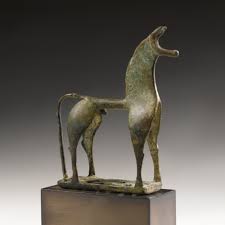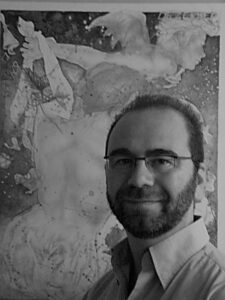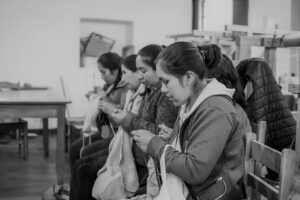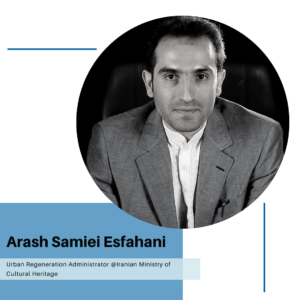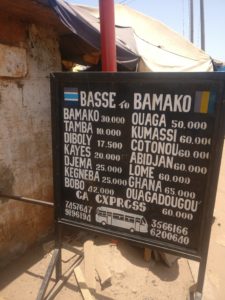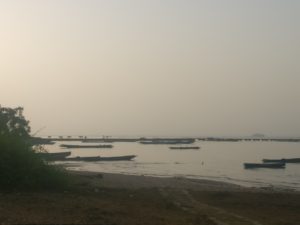: Uncategorized
Greece wins case over Sotheby’s for an 8th-Century BC Horse Statue
In April 2018, Sotheby’s listed a bronze horse, in the Corinthian style and unmistakably from Greece, for auction. The Greek ministry of culture became suspicious of its origins after finding out it was purchased from Robin Symes, a notorious art dealer who was a key player in an international criminal antiquities looting network. The Ministry requested the lot be withdrawn for sale until its background could be researched thoroughly.
In an unusual response, Sotheby’s and the horse’s owners, the Barnetts, sued the country, requesting permission to sell the horse and seeking reimbursement for court costs and attorneys’ fees. If successful, the case could have put the onus on source countries to prove that items have left their borders illegally.
Dr Evangelos Kyriakidis, director of the Heritage Management Organization, says: “Currently the onus of proof lies with auction houses who need to ensure the items they sell do not violate any legislation. This ruling strengthens this requirement and makes it unlikely to be challenged again any time soon.
“There is, however, one aspect that may soon prove quite important. The appeals court decided that mobile items of heritage (like their immobile counterparts) are part of the sovereignty of source countries and therefore are not subject to the same rules as all other business transactions.”
You can read more background on the case here.
“TEACH FOR FUTURE” – a project on the educational transformation of adults in Romania, Bulgaria and Greece
A new exciting collaboration has just started for us; “TEACH FOR FUTURE”, an Erasmus+ initiative that aims on the educational transformation of adults in Romania, Bulgaria and Greece through Innovation, Technology and Entrepreneurship.
Dr Emmanouel Garoufallou, Assistant Professor at the Department of Library Science, Archives and Information Systems, School of Social Sciences at the International Hellenic University and Project Manager of “TEACH FOR FUTURE”, shares with us a few words about the project.
Teach for the Future: what is this project about and when did it start?
“TEACH FOR FUTURE” is a strategic project on the educational transformation of adults in Romania, Bulgaria and Greece. Starting with November 2019, the National Association of Public Librarians and Libraries of Romania – ANBPR and its partners Global Libraries Bulgaria Foundation, Bulgaria, and the Heritage Management Organization (HERITΛGE) have started to implement the project.
Who are the partners of this project?
The project is funded under the European Union Erasmus+ program, Key Action 2, Strategic Partnerships, and foresees activities in the partner countries – Romania, Bulgaria and Greece. The initiator of the project, ANBPR, has the status of consortium leader, having as partners Global Libraries Bulgaria Foundation, Bulgaria, and the Heritage Management Organization (HERITΛGE), Greece, as well as associated partners from all three countries involved: National Library of Romania, Metropolitan Library of Bucharest, County Library “Octavian Goga” Cluj, “Panait Istrati” County Library Brăila, “Kájoni János” County Library Harghita, Bulgarian Library and Information Association (Bulgaria), Learning for Life (Greece) and the American Farm School in Thessaloniki (Greece).
What purpose does it serve?
Through “TEACH FOR FUTURE” Erasmus+ initiative, the consortium of partners aims to contribute to improving and extending the offer of high quality learning opportunities on innovative educational topics, with potential for economic growth, acquiring and recognizing new skills, knowledge and behaviors in line with the demands of the labor market by adults with a low level of training, so that they better respond to the demands of the current working environment, governed by technology, interdisciplinarity and transnational cooperation.
Who is this programme for?
The project represents an educational intervention dedicated to adults, which aims to create a transnational and multisectoral network through which a number of facilitators from Romania, Bulgaria and Greece, multipliers of skills training in the fields of IT, Management of Innovation & Network Collaboration and Entrepreneurship & Leadership, will transfer specialized knowledge from these thematic areas to heterogeneous communities of adult learners from the three countries, but also from the region.
How has the pandemic of Covid19 affected the programme?
Despite the unfavorable context determined by the COVID-19 crisis, the TEACH FOR FUTURE team ensured the project operational continuity, focusing in particular on the activities that did not involve face-to-face participation, but only remote consulting and technological modern means.
What actions have been taken so far?
Three Centers of Excellence have been created, one in each partner country, starting with January 2020. ANBPR Romania, Global Libraries Bulgaria Foundation in Bulgaria and Initiatives for Heritage Conservation in Greece, as members of the consortium, have agreed to establish three Centers of Excellence in Bucharest (Romania), Sofia (Bulgaria) and Thessaloniki (Greece), with the purchase of 3D Printing equipments for the use of these centers. At the same time, in early March 2020, the partners have started to set up a transnational and multisectoral network consisting of 10 facilitators with mixed competences, which will subsequently become training multipliers for 210 adults from partner countries. These trainers will transfer specialized know-how to heterogeneous communities of adult learners through local sessions and mentoring campuses hosted in each of the three countries.
In February 2020, ANBPR Romania, with the involvement of partners from Greece and Bulgaria, started developing an innovative educational tool, in order to standardize the digital education of adults. Designed to facilitate to the trainers the use of various ICT teaching methods and techniques, this Methodology will address four educational topics – 3D modeling and printing, image editing, digital marketing and online collaboration tools – aimed at stimulating learning and facilitating the assimilation and consolidation of this knowledge by adult learners.
Also, HERITΛGE, assisted by the Romanian and Bulgarian partners, started developing a training curriculum for adult learners in the field of Management of Innovation & Network Collaboration, following the adults’ understanding of the management of innovation principles and its intersections with other management areas.
Comment from our director:
The ‘Teach for the Future’ is particularly important for our organization as it improves our capacity in two key sectors that we are interested in for the sake of the Heritage Management Organization: Distance learning and Entrepreneurship. The latter, when combined with heritage management, can turn heritage into a powerful and sustainable resource for economic development. Through this program, HERITΛGE will be able to deliver higher quality education in this field to heritage managers. We thank Manolis for his continued engagement and his attention to detail.
Network Stories: Carlos Miguel Silva Canessa
Describe your organization and the unique work that it is doing. Who and what are affected by the work? How does/will the work impact people’s lives?
The Andean Baroque Route, promoted by the Society of Jesus, includes the churches of the Compañia de Jesus of Cusco, San Pedro Apostol of Andahuaylillas, San Juan Bautista of Huaro and the Chapel of the Virgen Purificada Chapel of Canincunca.
These churches were built in the sixteenth century; they own an extraordinary pictorial richness (murals and canvases); sculptures, with beautifully carved cedar altars covered in pan de oro gilding; and their architecture are important adobe structures. The route begins in the heart of Cusco and runs south of the valley. During Incan and colonial times an important trade route flourished, silver was transported from Potosi and coca leaves from the rainforest. The trade route is presently a tourist circuit. The churches were enriched with a range of decorations from the sixteenth through the nineteenth centuries. We find depictions of local flora and fauna, as well as vernacular traditions featuring the worship of the sun and the moon. The churches are canvases depicting different styles, however, the Andean Baroque predominates.
The Andean Baroque Route has four objectives. First, to promote the recovery, conservation, and dissemination of the route. Second, promote local culture. Many artistic projects are held here, most notably the Symphony for Peru, a project spearheaded by the great tenor Juan Diego Flores that includes a “lutherie” workshop (for making instruments), as well as a chorus and orchestra featuring local children and teenagers. Third, to contribute to the touristic development of the area to generate job opportunities to their citizens through restaurants, hostels, handicraft market, etc. Finally, develop a variety of social works: including, artisan training projects, a program to fight human trafficking, educational activities for children and teenagers through the educational play center programs, computer classes, reading nooks, and social assistance in the form of soup kitchens.
Tell us about a project that has benefited from the training you received from us? Why was the project important? Was there anything unusual or surprising about the execution of this project?
As president of the Andean Baroque Route I had the great opportunity to participate in the field school, Engaging Local Communities in Heritage Management through Archaeological Ethnography, organized by Heritage Management Organization in July of 2018. This program was focused on acquiring training in the fields of archaeological ethnography, community archaeology and heritage management, while delving into the daily life of the rural community of Gonies, in central Crete. Investigating the local community involvement with their material and intangible heritage was a central component of the program.
The international participants paired with the field school professors provided an enriching experience. The guidance of Dr. Aris Anagnostopoulos, professor of Archeological Ethnography and community engagement and Dr. Eleni Stenafou, professor of Oral History and Concepts of Heritage, was invigorating. I cannot forget the people of Gonies who enriched us with their stories made possible by the interviews that we had with them. My peers with their variety of experiences and formation also enriched the experience, hearing the different local realities across Colombia, Moldova, Spain, Peru and the United States provided a deeper richness to the field school. We learned from the professors, the local people and from each other.
The HMO field school allowed me to gain greater knowledge, develop abilities and open new perspectives to improve our services in the Route in the articulation with the communities in our patrimony. I obtained tools to dialogue with the local people in order to understand what they are looking for; how they imagine their future and how they consider that the Andean Baroque Route can enrich their lives. We are working towards a collective process, together building a dream where local people and the project Andean Baroque Route share a sustainable and common future. A project that leads people to value their heritage, to be more participative in the development of the area and to give an original experience where the local and the visitors can build an unforgettable experience that enriches both of them.
Has your organization worked on any other projects that are innovative, globally significant and can be replicated in a local market?
The Andean Baroque Route is a unique and globally significant project because of the articulation of four elements. The first element is recovering and preserving the heritage of the churches. Second, the promotion of culture through the preservation of the local tradition and artistic events. The Route, thirdly, contributes to the touristic development of the area, allowing for job opportunities for local citizens (restaurants, hostels, handicraft market, etc.). The Route allows us to develop social work in the area, especially for children and women. Children participate in a daily nutrition program where children receive a nutritious meal every day, as well as help and training in our libraries and computer centers. All in the hands of a team who monitors the wellbeing of the child both within the program and at home, therefore, reducing the violence the child is exposed to. The combination of heritage, patrimony, tourism, and social work makes the Andean Baroque Route one of kind in its impact both for the local community and for all its visitors.
The Andean Baroque Route promotes fair trade through its two gift shops which offer visitors fair trade items, such as textiles and ceramics, produced by local people. The gift shops are also a place for the commercialization of essential oils obtained from medicinal and aromatics plants that come from local fields. Artisans have become eager entrepreneurs, the economic motors of their homes, especially women.
What are the global issues that your project addresses (e.g., fighting climate change, preserving heritage and culture, promoting local participation)?
– Preserving heritage through restoration, conservation and maintenance: The Andean Baroque Route helped restore these works, such as the World Monuments Fund, French International Cooperation, Repsol, Enel, Backus, and many others who have recognized the importance of our cultural heritage. The Andean Baroque Route helps promote the recovery, conservation, and dissemination of a route that is truly alive! Here, life is celebrated in all of its dimensions. In addition, we have a second phase of restoration including churches of San Juan Bautista of Ccatcca, San Pablo de Ocongate, Chapel of Kuchuwasi (Ocongate), and San Francis of Marcapata. The churches of Ccatcca and of Ocongate have been already restored. We are looking for a restoration of Kuchuwasi chapel and we are working with Peru’s Ministry of Culture of Peru the restoration of church in Marcapata.
– Promoting local participation and preserving culture: Give an experience that articulates tourism and local traditions from a sustainable tourism perspective. The duality of this challenge includes offering tourists the possibility to know the past through heritage of the churches and an opportunity to interact with the local people who maintain Incan traditions. The second component of this challenge is working with the population to offer them the tools to build conditions for sustainable tourism while interacting with tourists in a way that maintains their traditions.
– Ecological aspect: The Andean Baroque Route is located in the Peruvian Andes, which are extremely vulnerable in face of climate change. The increase in temperature produces intense rains that could affect the churches, but especially the lives of the population because agricultural production is the main way of life. The snowy mountain Ausangate (6,384 meters) is also located in the region; the increase of temperature would melt the snow and dramatically change the landscape.
Living in quarantine: the journal
COVID-19 has upended life as we know it. These anxious and unusual times bring unforeseen difficulties that make us feel disruption and uncertainty. But it’s also times like these when we need one another most, to share thoughts and experiences in order to successfully cope in this crisis.
Members and partners of the HERITΛGE share with us aspects of their everyday lives, concerns about the present, aspirations about the future.
What is the situation in your country after the onset of Covid-19?
Like other countries all around the world, the circumstances are not quite perfect for Iran. On the one hand, communities are working hard to protect their revenues. While the government is trying to save the economy and keeping society health. But the key point here is that COVID-19 has entered into Iran in the period that we were finding new ways to reduce the destructive impacts of sanctions and trade restrictions.It can’t be said that the side-effects of this pandemic have had little impact on our cities.
But in comparison to some countries which are not in our sanctions, we are doing much more better. We have done good acts to level the shock of this crisis into society. Although next to governmental effective performances the major part of this achievement goes back to NGOs and benevolent individuals participations.
In a general view shutting down and semi-open of medium and small scale businesses are the most challengeable impact on my own country. Although, almost all educational and training institutions like schools and universities or gyms got closed too. Moreover, transportation restrictions have had another influence on the routine conditions in the
country.
It had been hoped that with quite intelligently working on own natural, human and cultural resources we could open new opportunities for compensation resulted from lack of permission of exporting oil and gas. Consequently, we were planning to tackle obstacles for all travelers and further investment in the tourism industry.
How do you think it will affect the heritage organizations and practices in the future?
As much as the heritage management affairs are run by the government in Iran it is assumed that this pandemic won’t make a drastic change in the main structure of the ministry of (MCTH). However, it is not far away from the mind that facing this situation may lead to opening the gates for outsourcing some activities and privatizing some clusters and sectors.
Most important changes might appear in the tourism department. It is predicted that the national policymaking might be turned out to provincial policymaking, especially for summer vacations. For domestic journeys those provinces that are secured seems that they are allowed to receive guests. Although they should follow healthy instructions and
protocols. In this term, the government will take more the role of observant in the provinces and devolve its implementation missions to private sectors hereafter.
In respect of all other departments of MCTH, decreasing the income share of internal and abroad travels will cause the reduction of the executive and research projects budgets. It is supposed to create some innovative solutions to replace missed financial sources.
In this case maintenance of world heritage sites, restoration of prominent monuments and structures, various handicrafts workshops and corresponded jobs, most of the archaeological excavations and most of the anthropological research projects will be reorganized after supplying new resources.
What will be your next steps?
Unfortunately, the state of the economy is falling to another slope after increasing the second wave of the pandemic. Besides, the sanctions alongside this matter are going to make a massive pressure on those people who are directly and indirectly dependent on cultural heritage for their subsistence.
Preparing financial backup frameworks for all clusters of heritage affairs, supporting handicraftsmen using technology for making more facilitation in trading their artworks, analyzing database in order to predict probable hypothesis on the needs of each heritage site for protecting and conserving them, simplifying all allowance issuing procedures for
creating new related businesses, establishing e-learning campaigns, accelerating and incubating start-up ideas and making new strategies for supplying finances for research projects are the logical priorities of tackling the consequences of the pandemic.
How do you experience it individually and how does the organization you work for deals with it?
As an urban regeneration vice-chancellor working in one of the municipalities of Iran, I imagine that urban heritage is suffering from this situation too but less than other kinds of heritage. They are extremely under control of municipalities while are being used by people less than the past.
Being in this position has made a golden capacity for reviewing them as cultural resources and getting ready for making new strategies for proposing some creative ideas in order to achieve urban regeneration targets. Besides, stuck into trouble in social and economic dimensions have made this possible for claiming to attract the covering budgets from
GNGOs, FBOs and associations. Even in some cases, this chance is available to make the contemporary bills as necessary demands to issues of new regulations and rules.
All in all, despite all concerning threats on heritage field I personally feel this pandemic as the opportunity in terms of heritage management. I believe that notwithstanding all suffer that people are bearing, hope is still alive and people could cross over this situation alongside together.
What is the situation in your country after the onset of Covid-19?
Bologna is in lockdown and implementing social distancing. Only essential production is active. The economy is plummeting.
How do you experience it individually and how does the organization you work for deals with it?
My social life is reduced to online interaction. The agency I work for allows to work full time from home.
How do you think it will affect the heritage organizations and practices in the future?
Heritage institutions are now closed to the public and heritage consultancies are stuck. As long as mobility is limited, heritage organisations will have to find new ways of engaging the public and sustain themselves. Digital and virtual seem to be the new paths, but are they?
What will be your next steps?
Reflect on how to make heritage relevant to people in the changed scenario through new heritage interpretation practices.
What is the situation in your country after the onset of Covid-19?
Like all over the world with social distancing, state borders are closed in Queensland, people are working from home, record government subsidies, etc.
How do you experience it individually and how does the organization you work for deals with it?
My family can’t visit to see my newborn due in a few weeks. But professionally we are still working in the office since there are no cases of Covid-19 in our region.
How do you think it will affect the heritage organizations and practices in the future?
Financially for sure, but I think all will turn back to normal if they are able to survive with subsidies.
What will be your next steps?
Staying in, and trying to stay connected with family friends, and professionally via virtual means.
What is the situation in your country after the onset of Covid-19?
The situation in India is like that of being in top of a nuclear reactor. They took measures in time but given the population and the access to decent quality of healthcare, things could go for a toss if the spread occurs.
How do you experience it individually and how does the organization you work for deals with it?
This lockdown has hit my organization, Access For ALL, hard as our primary work is inclusion, tactile experiences, participatory activities and bringing people together, which has suddenly become a taboo. Individually, I am doing fine as this is a time to take things slow, learn new things, deal with ambiguity of life and since I teach, I have been conducting online classes.
How do you think it will affect the heritage organizations and practices in the future?
First of all, it will surely impact tourism which in-directly affects the upkeep of the the heritage sites and monuments. For some sites it actually good as per conservation perspective that they are having less or as of now no people. And I believe that this will affect the jobs of some people. For consulting organizations, it is pushing them to see how can they explore things digitally. So it is a little different and difficult phase, which I am sure shall pass soon.
Second and positive thought is that we are writing history, we are somehow going to be part of a timeline that will be seen as archive for artists, inspiration for writers and stories for those who survive it. So great time to document this milestone of time.
What will be your next steps?
Personally I’m working on safeguarding myself and seeking basic financial planning for at least a year. This is my top priority. Then we are collaborating with various organizations to offer free, as well as paid sessions on mental health, arts based engagement and learning for those with special needs. We are urging museums to explore digital accessibility. Let’s see what’s in store for us in future. It’s like a war, each day is a new day! I hope that we all win this war hale and hearty!
What is the situation in your country after the onset of COVID-19?
Τhe country boarders in Namibia are closed and two regions popular with tourism were on lock down until 16th April. Up to today only 16 cases reported and 3 have recovered and no deaths.
How do you experience it individually and how does the organization you work for deals with it?
Personally, it is very isolating because I can’t see friends and loved ones. I try to exercise everyday before I start my day and do my hobbies, which is craft, during my free time. At work, we are teleworking because we had put a Business continuity plan in place already in February. We are having a lot of Skype meetings and emails exchange.
How do you think it will affect the heritage organizations and practices in the future?
Heritage Institutions like museums, galleries, craft centres and heritage sites are closed leading to financial and job loss. There is need for massive promotion domestic tourism. Because even if the boarders open, internationally will take a while to pick up but nationally people might want to go outside their home for some adventure.
What will be your next steps?
We will work with the Ministry of Cultures and other partners on how to prepare the heritage sector for such crisis.
Joshua Mwankunda, Manager at Ngorongoro Conservation Area Authority
“We have very few cases of COVID-19 and only one death in Tanzania, so there is no panic whatsoever about the pandemic. What is the profound effect is tourism. Normally we would have a lot of tourists this year and we would be expecting revenues equal to 70 million USD. Unfortunately, this means that we will have to have direct support from the government and friends of Conservation for the loss of income in order to support the basic activities of protection and conservation.”
"Importance of digital tools for heritage documentation and management" by Dr. Cornelis Stal
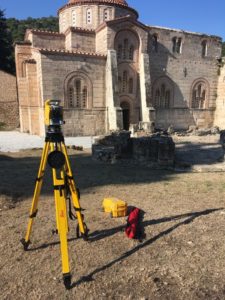
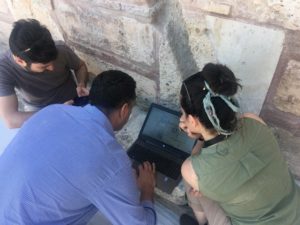
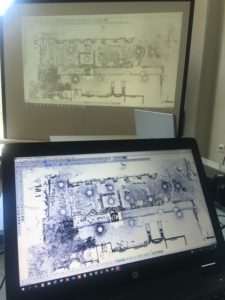
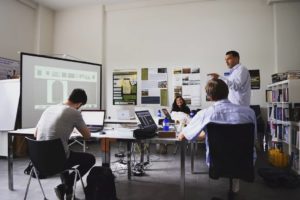
Dr. Cornelis Stal
Manager of H-digital, The Heritage Management Organization digitization program.
Convenor of the annual ‘Digital Tools for Heritage Management’ executive workshop by The Heritage Management Organization.
Lecturer/Researcher, Ghent University College – HOGENT, Belgium
"The Way to Dusty Death" by Kenneth Aitchison (PhD), Head of Capability Mapping – The Heritage Management Organization
Tomorrow, and tomorrow, and tomorrow,
Creeps in this petty pace from day to day,
To the last syllable of recorded time;
And all our yesterdays have lighted fools.
The way to dusty death
Shakespeare – Macbeth
Basse Santa Su is a quiet town, more than 300km upriver from the coast in The Gambia. I was there in May 2019 to build partnerships for HERITΛGE – we were looking to develop a project to provide training for Gambian heritage managers, as the European Commission had put out a call for proposals.
I was fascinated by this advert for in bus tickets by the road in the town centre.
A bus to Ouagadougou! In Burkina Faso! Wow, how long would that take!?
My Gambian colleague told me it would take three or four days. He was glad I had spotted this, because that bus journey is the start of the ‘back way’.
The Gambia is a poor country. Tourism, and ground nut (peanut) production are the two biggest sectors of the economy. Historically, remittances from Gambians working in other countries have also supported a lot of families in the homeland, and for a long time the preferred work was in the oil industry, specifically in Libya. But the revolution in Libya in 2011 put an end to much of that.
The Ebola crisis in West Africa in 2014, which carried on until 2016, badly affected tourism – there were no Ebola cases in The Gambia, but knowing that it was in Guinea, Liberia and Sierra Leone was enough to frighten away a lot of tourists. And so the economy suffered.
And so the lack of jobs and opportunities has meant that over recent years, many Gambians have decided to risk trying to go the back way to Europe – what is euphemistically called ‘irregular’ migration across the Sahara and the Mediterranean.
The back way is horribly formalised. People travel up-country to Basse, and buy a bus ticket to Ouagadougou. When they get there, a ‘travel agent’ will sell them another ‘ticket’ to go to Libya. And when – if – they arrive at the coast, they will then have to pay for a place on a boat.
It has been estimated that up to one third of the people who try to go the back way die en route, either in the desert or in the sea. Some villages have lost as much as half of their population to the back way.
Thinking back to the bus from Basse to Ouagadougou – it costs 60,000 Gambian Dalasi, the equivalent of just over €1,000 or US$1,200.
In 2017, Gambian GDP per person was $483.02 = 23,885 Dalasi. That one ticket costs more than two years wages. And that only gets to Burkina Faso. The longer, riskier, more expensive legs of the back way start there. People, and their families, are being crushed by debt to pay for this – with little chance of them reaching a ‘promised land’ at the end of it.
In 2017, The Gambia underwent a transition to true democratic rule. The Government of The Gambia, together with the European Union, wanted to make efforts to reduce irregular migration. And this is the logic behind the project I was in The Gambia to develop a partnership for.
If people are better trained as heritage managers, then heritage businesses (whether they are in the private or state sectors) will be better run. Better run enterprises can employ more people, and give them more secure, better jobs. People with better jobs are less likely to be lost to the back way. And so investment in heritage management training can contribute to a reduction in irregular migration.
The Gambia has a history of losing people. Alex Haley’s 1976 book Roots: the saga of an American family starts in The Gambia – the protagonist, Kunta Kinte, is a young Gambian man who is enslaved by Europeans in the middle of the 18th century, and like Kunta Kinte, thousands of people were transported down the River Gambia and sold in the Atlantic slave trade.
James Island, the site of a colonial fort used in the exploitation of gold, ivory and humanity, was renamed Kunta Kinte Island in 2011, the year before the site was inscribed on the list of World Heritage Sites. Where there is heritage-focussed tourism in The Gambia, this is largely related to the history of enslavement. It is hoped that now, developing skills and expertise in managing and commemorating the loss of Gambians to the slave trade, will help to mitigate against the loss of modern Gambians to the back way.

